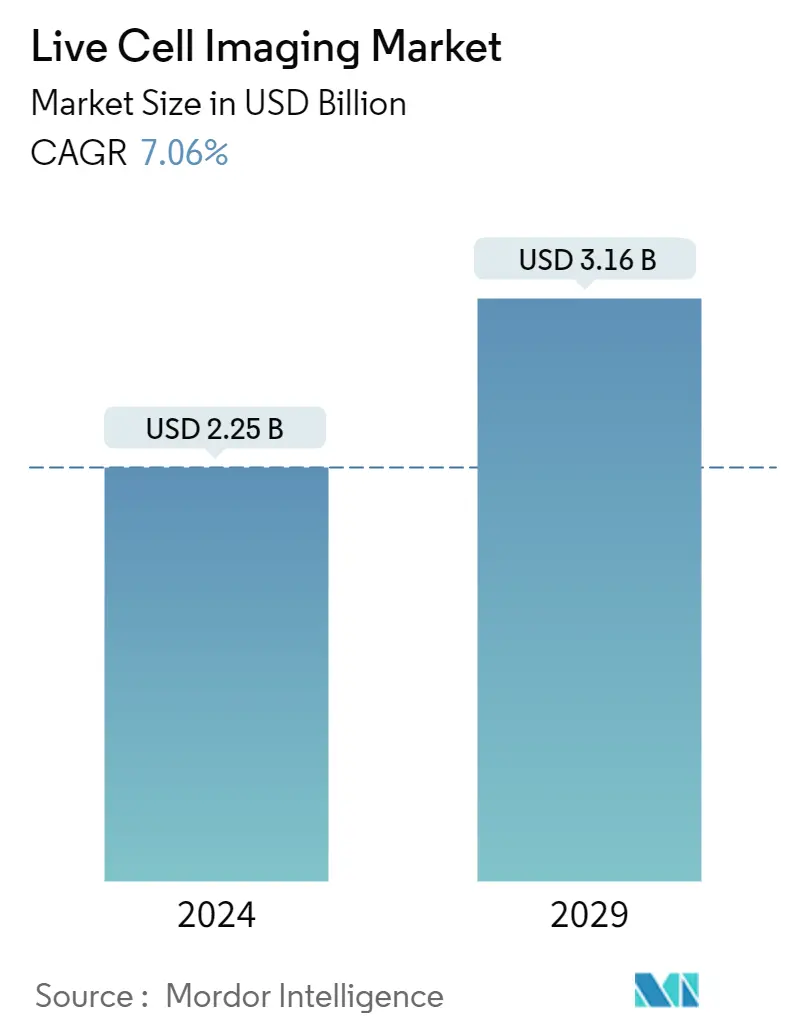Market Size of Live Cell Imaging Industry

| Study Period | 2019 - 2029 |
| Market Size (2024) | USD 2.25 Billion |
| Market Size (2029) | USD 3.16 Billion |
| CAGR (2024 - 2029) | 7.06 % |
| Fastest Growing Market | Asia-Pacific |
| Largest Market | North America |
Major Players
*Disclaimer: Major Players sorted in no particular order |
Need a report that reflects how COVID-19 has impacted this market and its growth?
Live Cell Imaging Market Analysis
The Live Cell Imaging Market size is estimated at USD 2.25 billion in 2024, and is expected to reach USD 3.16 billion by 2029, growing at a CAGR of 7.06% during the forecast period (2024-2029).
The COVID-19 pandemic had a severe impact on the market as there were supply chain disruptions due to the lockdown. However, the increasing demand for the early diagnosis of COVID-19 infection in order to develop an effective vaccination propelled the growth of the market as it led to increasing usage of the live cell imaging process. According to a research study published in Antiviral Research Journal in November 2021, a live-cell-based test for assessing the intracellular function of the CoV2 target, the Main 3C-like protease, was created, which is important and highly conserved (Mpro) and this method provided a high-throughput COVID-19 Main Protease (Mpro) screening system. The rising application of live-cell imaging in the identification of intracellular functions in COVID-19 led to increased adoption of live cell imaging and considerably impacted the market studied during the pandemic. Therefore, the increasing usage of live cell imaging equipment for the study of the molecular biology of the COVID-19 virus is expected to drive the growth of the market over the forecast period.
The growth of the live cell imaging market is attributed to the adoption of high-content screening techniques in drug discovery, the rising prevalence of chronic disease demanding higher and quicker diagnostic facilities, and government funding for cell-based research.
Live-cell imaging is a detection mode for cell-based assays and high-content screening techniques in drug discovery that helps in the identification of multiple measures of cell physiology, whether from sub-cellular compartments, multicellular structures, or model organisms. According to a study published in Frontiers in Cell and Developmental Biology in January 2021, high-content screening has aided in the comprehension of varied downstream effects for multiple treatments on cancer cells, specifically organelle targets, estimating the overall cellular response efficiently for new candidate molecules, and evaluating signaling heterogeneity. The rising advantages of high-content screening in understanding cancer cell response to novel drugs are expected to drive the adoption of the devices used for live cell imaging for the development of novel cancer treatments and fuel the overall market growth.
Besides, the development of innovative products is also contributing to market growth. For instance, in June 2021, Leica Microsystems launched the Leica Nano workflow, a new live-cell correlative light, and electron microscopy (CLEM) workflow solution designed to increase experimental success rates, improve reproducibility, and simplify light and electron microscopy (EM) integration. In addition, in January 2021, Zeiss Group launched the ZEISS Visioner 1, an innovative digital microscope for live-cell imaging that facilitates all-in-one focus in real-time through its Micro-mirror Array Lens System (MALS). This initiative is aimed at simplifying the imaging process and delivering higher throughput. Therefore, these developments in the market are predicted to garner the market's growth over the forecast period.
However, factors such as the high cost of high-content screening systems and the shortage of skilled professionals may hinder the growth of the market.
